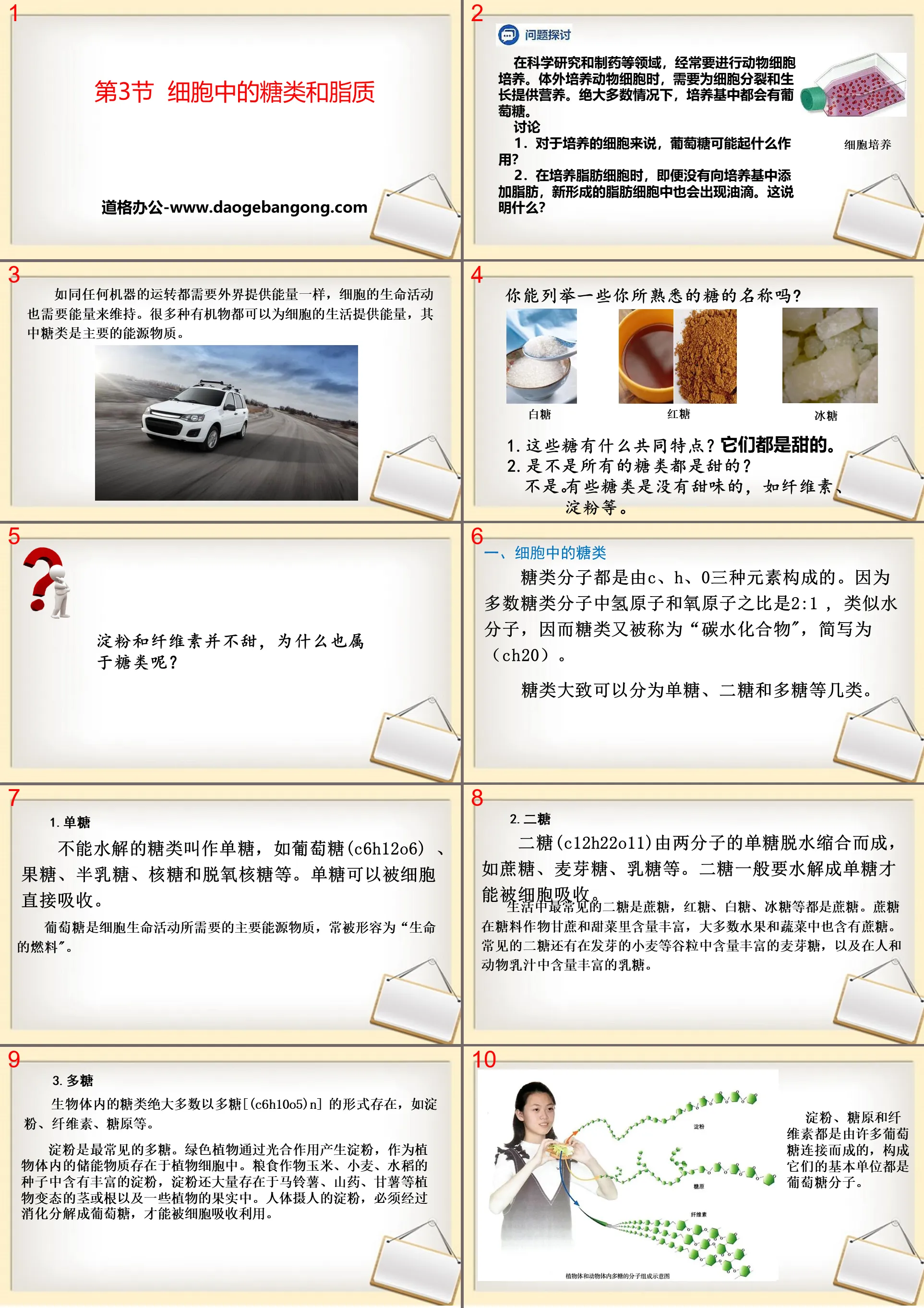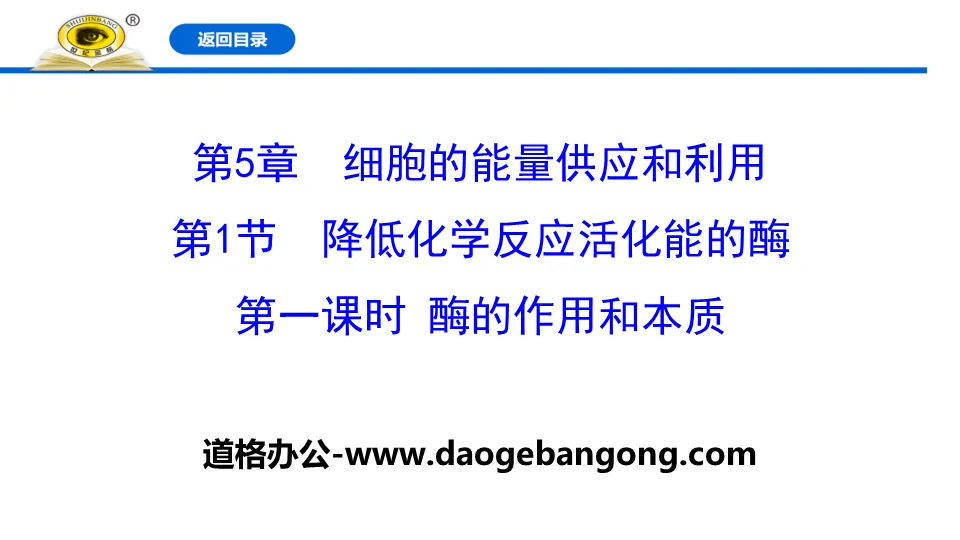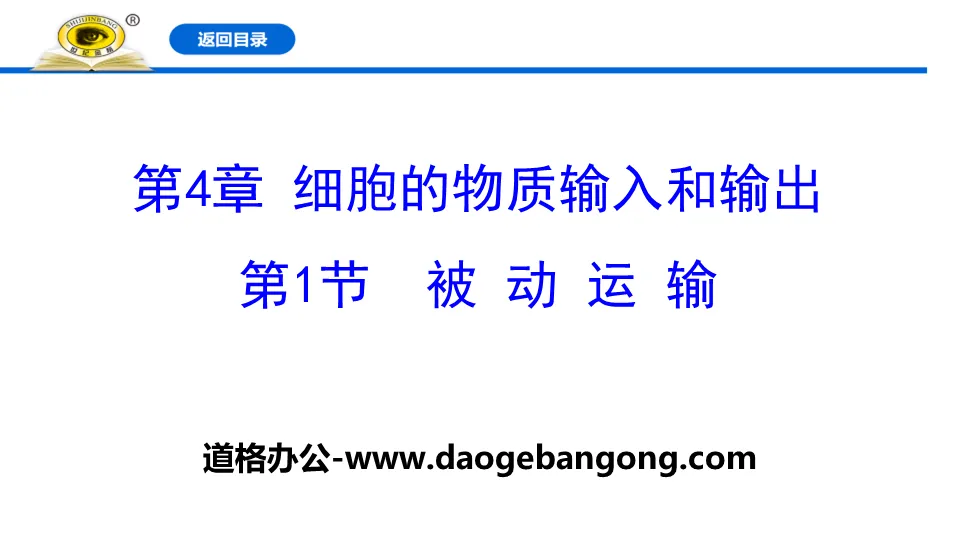
| Category | Format | Size |
|---|---|---|
| High School Biology Compulsory Course 1, published by People's Education Press | pptx | 6 MB |
Description
"Carbohydrates and Lipids in Cells" Molecules that make up cells PPT
Part One: Discussion of the Problem
In fields such as scientific research and pharmaceuticals, animal cell culture is often performed. When culturing animal cells in vitro, nutrients need to be provided for cell division and growth. In most cases, glucose will be present in the culture medium.
discuss
1. What role might glucose play in cultured cells?
2. When fat cells are cultured, oil droplets appear in the newly formed fat cells even if no fat is added to the culture medium. What does this mean?
Just like the operation of any machine requires energy from the outside, the life activities of cells also require energy to maintain. Many kinds of organic matter can provide energy for cell life, among which sugar is the main energy substance.
Can you name some sugars you are familiar with?
1. What do these sugars have in common?
2. Are all sugars sweet?
Sugars and lipids in cells PPT, part 2 content: 1. Sugars in cells
Sugar molecules are composed of three elements: C, H, and 0. Because the ratio of hydrogen atoms to oxygen atoms in most sugar molecules is 2:1, similar to water molecules, sugars are also called "carbohydrates", abbreviated as (CH20).
Sugars can be roughly divided into several categories: monosaccharides, disaccharides and polysaccharides.
1. Monosaccharides
Sugars that cannot be hydrolyzed are called monosaccharides, such as glucose (C6H12O6), fructose, galactose, ribose and deoxyribose. Simple sugars can be absorbed directly by cells.
Glucose is the main energy substance required for cell life activities and is often described as the "fuel of life".
2. Disaccharide
Disaccharide (C12H22O11) is formed by the dehydration condensation of two molecules of monosaccharides, such as sucrose, maltose, lactose, etc. Disaccharides generally need to be hydrolyzed into monosaccharides before they can be absorbed by cells.
The most common disaccharide in life is sucrose. Brown sugar, white sugar, rock sugar, etc. are all sucrose. Sucrose is abundant in the sugar crops sugarcane and sugar beet, and is also found in most fruits and vegetables. Common disaccharides include maltose, which is abundant in grains such as sprouted wheat, and lactose, which is abundant in human and animal milk.
3.Polysaccharides
Most of the sugars in living organisms exist in the form of polysaccharides "(C6H10O5)n", such as starch, cellulose, glycogen, etc.
Starch is the most common polysaccharide. Green plants produce starch through photosynthesis, which is present in plant cells as an energy storage substance in the plant. The seeds of food crops corn, wheat, and rice are rich in starch. Starch is also found in the abnormal stems or roots of potatoes, yams, sweet potatoes and other plants, as well as in the fruits of some plants. The starch ingested by the human body must be digested and broken down into glucose before it can be absorbed and utilized by cells.
Starch, glycogen and cellulose are all made up of many glucoses connected, and their basic units are glucose molecules.
PPT on carbohydrates and lipids in cells, part 3: 2. Lipids in cells
Similar to sugars, the chemical elements that make up lipids are mainly C, H, and O. Some lipids also contain P and N. Unlike sugars, the oxygen content in lipid molecules is much lower than that of sugars, and the hydrogen content is higher.
1. Fat
Fat is the most common lipid.
Fat is an ester formed by the reaction of three molecules of fatty acids with one molecule of glycerol, namely triacylglycerol (also known as triglyceride).
Fatty acids can be saturated or unsaturated. Most vegetable fats contain unsaturated fatty acids and are liquid at room temperature; animal fats contain saturated fatty acids and are solid at room temperature.
The oxidative decomposition of 1g glycogen releases about 17kJ of energy, while 1g of fat can release about 39kJ of energy. Fat is a good energy storage material in cells and can be broken down and used when life activities require it.
Fat is not only an energy storage material, but also a good heat insulator. Large mammals living in the ocean, such as whales and seals, have thick layers of fat under their skin to keep them warm. Penguins living in the cold environment of Antarctica can have body fat as thick as 4cm. The fat distributed around the internal organs also has a buffering and decompression effect, which can protect the internal organs.
2. Phospholipids
The difference between phospholipids and fats is that one of the hydroxyl groups (-OH) of glycerol is not combined with fatty acids to form esters, but is combined with phosphoric acid and other derivatives. Therefore, in addition to C, H, and O, phospholipids also contain P and even N.
Phospholipids are important components of cell membranes and the membranes of various organelles.
3. Sterols
Sterols include cholesterol, sex hormones, and vitamin D.
Cholesterol is an important component of animal cell membranes and is also involved in the transport of lipids in the blood in the human body. Sex hormones can promote the development of reproductive organs and the formation of germ cells in humans and animals; vitamin D can effectively promote the absorption of calcium and phosphorus in the intestines of humans and animals.
Sugars and lipids in cells can be converted into each other. In addition to being used by cells, the excess glucose in the blood can be synthesized into glycogen and stored; if there is still excess glucose, it can be converted into fat and certain amino acids. But there is a significant difference in the degree of conversion between sugar and fat. For example, sugar can be converted into fat in large amounts when the supply is sufficient; fat will only be decomposed for energy when carbohydrate metabolism is disrupted, causing insufficient energy supply, and cannot be converted into sugar in large quantities.
PPT on carbohydrates and lipids in cells, part 4: practice
1. A classmate suddenly felt dizzy without eating breakfast. The school doctor gave him glucose water. The main reason for doing this was ( )
A. Replenish water B. Provide various nutrients
C. Meet energy needs D. Dilute the blood
2. In the following description, the common characteristics of starch, cellulose and glycogen are ( )
A. They are all substances that store energy in cells.
B. Both contain 4 elements: C, H, O, and N.
C. Its constituent monomers are all glucose
D. They are all reducing sugars
3. Carbon is the most basic element that makes up living organisms. This is because carbon is in living organisms ( )
A.Contains the most energy B.Easiest to be absorbed and utilized
C. Plays the greatest role D. Forms the skeleton of organic matter
Keywords: Free download of PPT courseware for high school biology compulsory course 1 from the People's Education Edition, PPT download of sugars and lipids in cells, PPT download of molecules that make up cells, .PPT format;
For more information about the PPT courseware "Molecular Composition of Cells, Sugars and Lipids in Cells", please click on the Molecules Making Up Cells ppt Sugars and Lipids in Cells ppt tag.
"Nucleic acid is the carrier of genetic information" PPT courseware of molecules that make up cells:
"Nucleic Acid Is the Carrier of Genetic Information" PPT Courseware on the Molecules Composing Cells Part One Content: Foundation of Necessary Knowledge Literacy 1. Types and Distribution of Nucleic Acids 1. DNA: Mainly distributed in _______, also in _______ and _______ Contains small amounts of DNA. 2.RNA:..
"Nucleic acid is the carrier of genetic information" PPT of molecules that make up cells:
"Nucleic Acid Is the Carrier of Genetic Information" PPT on the molecules that make up cells Part One: Question Discussion 1. Why can DNA provide information about criminal suspects? DNA is the main genetic material, and everyone's genetic material is different. 2.Can you also say D..
"Proteins are the main carriers of life activities" PPT download of the molecules that make up cells:
"Protein is the main carrier of life activities" PPT download of the molecules that make up cells Part 1: Foundation of necessary knowledge literacy 1. Function of protein (connected) 2. Amino acid, the basic unit of protein. Please combine the structure of the amino acid that makes up protein. ..
File Info
Update Time: 2024-07-02
This template belongs to biology courseware High School Biology Compulsory Course 1, published by People's Education Press industry PPT template
"Carbohydrates and Lipids in Cells" Molecules that make up cells PPT Simple campus recruitment activity planning plan summary enterprise and institution recruitment publicity lecture PPT template is a general PPT template for business post competition provided by the manuscript PPT, simple campus recruitment activity planning plan summary enterprise and institution recruitment promotion Lecture PPT template, you can edit and modify the text and pictures in the source file by downloading the source file. If you want more exquisite business PPT templates, you can come to grid resource. Doug resource PPT, massive PPT template slide material download, we only make high-quality PPT templates!
Tips: If you open the template and feel that it is not suitable for all your needs, you can search for related content "Carbohydrates and Lipids in Cells" Molecules that make up cells PPT is enough.
How to use the Windows system template
Directly decompress the file and use it with office or wps
How to use the Mac system template
Directly decompress the file and use it Office or wps can be used
Related reading
For more detailed PPT-related tutorials and font tutorials, you can view: Click to see
How to create a high-quality technological sense PPT? 4 ways to share the bottom of the box
Notice
Do not download in WeChat, Zhihu, QQ, built-in browsers, please use mobile browsers to download! If you are a mobile phone user, please download it on your computer!
1. The manuscript PPT is only for study and reference, please delete it 24 hours after downloading.
2. If the resource involves your legitimate rights and interests, delete it immediately.
3. Contact information: service@daogebangong.com
"Carbohydrates and Lipids in Cells" Molecules that make up cells PPT, due to usage restrictions, it is only for personal study and reference use. For commercial use, please go to the relevant official website for authorization.
(Personal non-commercial use refers to the use of this font to complete the display of personal works, including but not limited to the design of personal papers, resumes, etc.)
Preview




















